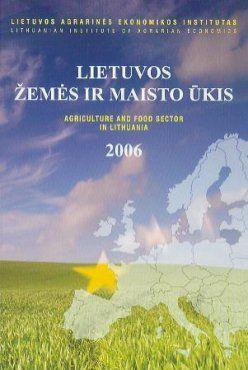
Agriculture in Lithuania performs a significant economic, social and environmental function. More than a half of the total land resources are suitable for agricultural activities. The rural population makes up 33.1% of the total country’s population. In 2006, the share of agricultural and food sector accounted for 9.1% in the total value added and amounted to 14.4% in total exports. About 11.5% of the population were engaged in agriculture and 4.5% in manufacture of food, beverages and tobacco products.
Lithuania as EU member country has the possibility to take advantages of the membership. An open single market and export subsidies make preconditions for a rapid growth of exports, while more active market and larger financial support increase income of economic entities.
In 2006 compared to 2005 the turnover of foreign trade increased by 31% and for the first time exceeded 10 bill. Lt. Over 2006, the exports of Lithuanian agricultural and food products went up by 29% and made up 5.4 bill. Lt; the imports increased by 33% and came to 4.9 bill. Lt. The positive foreign trade balance exceeded a half billion Litas. Dairy products made up the largest share in the structure of total exports of agricultural products. Germany, Latvia, Poland and other EU countries as well as Russia were the major partners of Lithuania‘s foreign trade.
The year 2006 was unfavourable for agriculture. Such natural disasters as early frosts, drought in summer and heavy rains resulted in lower harvest. In 2006 compared to 2005 the harvest of cereals declined by 34%, potatoes by 49%, field vegetables by 46%, rapeseed by 16%, sugar beet by 10%. The significantly lower output of plant production caused a considerable increase of purchase prices. The value of gross agricultural output of plant production made up only 90% of the 2005 level. The value of gross animal production went up by 17% due to increased production scope and higher purchase prices of milk and cattle and accounted for 56% of the gross agricultural output (in 2005 - 49.2%).
Good results are reached in the field of quality of agricultural and food products. The structural support under SAPARD and SPD helped the enterprises of the Lithuanian food industry to reorganise production according to EU standards. As a result, in 2006 the majority of meat, dairy, fish processing and other enterprises of the food industry had licences to supply products into the single EU market.
In 2006, there were 94.2 thousands of family farms in the Register and operated 558 agricultural companies and enterprises. More than 335 thousand of holdings were declared with the average size 12.4 ha, i.e. by 7.8% larger than in 2005. A considerable share of small semi-substance farms is one of the main obstacles impeding competitiveness in agricultural production. The other problem is the age of farmers: more than half of farmers are older than 55 years and only 16% are under 40. The aid under the measure Early Retirement, support of young farmers and other structural measures promise positive changes.
Many farmers and other rural businessmen lack knowledge and practical experience in management, implementation of new production technologies, agrienvironmental standards, good farming practice. Public finances enabled the rural population to improve qualification. In 2006 44 accredited advisory institutions provided consultations for farmers and other rural residents as well as 54 training institutions organised training. Training of human resources is a priority of the development of agriculture and food sector.
© Quoting requires reference to the source and website address.
